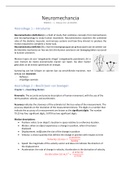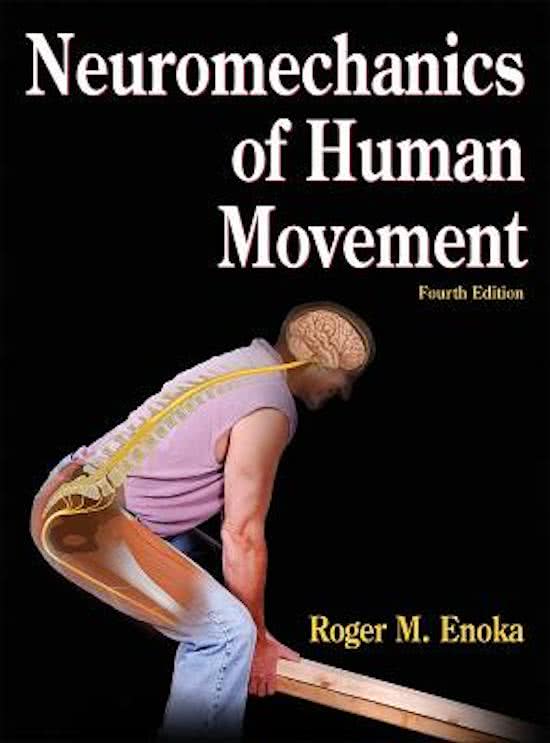Neuromechancia
BWB32 – L. Meijerink s4156056
Hoorcollege 1 – Introductie
Neuromechanics (definition) is a field of study that combines concepts from biomechanics
and neurophysiology to study human movement. Neuromechanics examines the combined
roles of the skeletal, muscular, and nervous systems and how they interact to produce the
motion required to complete a motor task.
Neuromechanica definitie (NL): Hoe het bewegingsapparaat gehoorzaamt aan de wetten van
de klassieke mechanica en hoe we dat slim kunnen aansturen om bewegingstaken succesvol
te kunnen uitvoeren.
Mensen lopen als een ‘omgekeerde slinger’ (omgekeerde pendulum), dit is
voor mensen de meest economische manier van lopen. Op deze manier
gebruiken ze de minste spierkracht en energie.
Aansturing van het lichaam en spieren kan op verschillende manieren, met
behulp van neuronen:
- Reflexen
- Vrijwillige controle
Hoorcollege 2 – Beschrijven van bewegen
Chapter 1 – Describing Motion
Kinematic: The accurate and precise description of human movement, with the use of the
terms position, velocity, and acceleration.
Accuracy indicates the closeness of the estimate tot the true value of the measurement. The
accuracy depends on the resolution of the measurement device. The digits in a number that
indicate the accuracy of a measurement are known as the significant digits. The number
79.25 has four significant digits, 0.079 has two significant digits.
Motion descriptions:
• Position: refers to an object’s location in space relative to a reference location.
• Motion: when an object experiences a change in position, when it has been
displaced.
• Displacement: ind[[icates the size of the change in position
• Velocity: a vector quantity that defines the change in position with respect to time
∆ 𝑝𝑜𝑠𝑖𝑡𝑖𝑜𝑛
𝑉𝑒𝑙𝑜𝑐𝑖𝑡𝑦 (𝑣) 𝑚/𝑠 =
∆ 𝑡𝑖𝑚𝑒
• Speed: the magnitude of the velocity vector and does not indicate the direction of
the displacement
• Acceleration: the rate of change in velocity. Acceleration is the derivative of velocity.
∆ 𝑣𝑒𝑙𝑜𝑐𝑖𝑡𝑦
𝐴𝑐𝑐𝑒𝑙𝑒𝑟𝑎𝑡𝑖𝑜𝑛 (𝑎) 𝑚/𝑠 2 =
∆ 𝑡𝑖𝑚𝑒
, • Gravity: -9.81 m/s2
Linear and Angular motion
Linear motion refers to an equivalent displacement in space of all the parts of the object.
Conversely, when all the parts of the object do not experience the same displacement (
position), the motion has included some rotation: angular displacement. A combination of
linear (translation) and angular (rotation) motion in a single plane is called planar motion
and involves rotation about a point that itself moving. In most human movement, our body
segments undergo both linear and angular motion.
Fig. I - Linear and Angular Symbols
Chapter 4 – Running, Jumping, and Throwing
Walking and running
When you’re walking there is always at least one foot on
the ground, and there is a brief period when both feet are
on ground. In contrast, running involves a period when
neither foot is on the ground (aerial time). In both walking
and running, however, each limb experiences a sequence
of support and nonsupport during a single cycle. The
period of support is referred to as the stance phase, and
nonsupport is known as the swing phase. The stance
phase begins when the food contacts the ground and stops
when the foot leaves the ground (toe-off). One complete
cycle, such as from left foot toe-off to left foot toe-off, is
defined as a stride. A stride comprises two steps with a
step defined as the part of the gait cycle from an event of
one foot tot the same event for the other foot, such as left
toe-off to right toe-off.
Fig. II - Footfall patterns during walking and running.
,Stride Length and Rate
Walking and running speeds (m/s) depend on two characteristics: stride length (m/stride)
and stride rate (strides/s). Running speed will increase if stride length remains constant and
stride time decreases (stride rate increases) or if stride rate remains constant and stride
length increases.
Increases in stride length to walk and run at faster speeds are accomplished by
increasing the angular displacements about the ankle, knee, and hip joints.
Because the knee joint flexes only slightly during the stance phase of walking, the
leg is often modeled as a rigid strut during the stance phase; this is known as the
inverted-pendulum model of walking.
Fig. III - Inverted-pendulum model
Jumping
A jump is a movement that causes the CM to be projected upward and the feet of the
performer to leave the ground. Jumps can be categorized in the vertical jump, the long jump,
and springboard diving (geen leerstof uit boek).
Vertical jump: When a person is asked to jump and reach as high as possible with the hands,
the typical strategy involves a technique called the countermovement jump. It is called a
countermovement jump because it begins with an initial movement in the direction of the
opposite to the takeoff direction. The acceleration is in two phases constant: (1) at the
beginning of the jump, (2) at approximately -10 m/s2 during the aerial phase when the only
force acting on the jumper is gravity (at the highest point).
Long jump: The purpose of the long jump is to maximize the horizontal distance between the
takeoff and the landing purpose. Leaning forward at takeoff and backward at landing adds
distance to the displacement of the CM and increases the jump distant.
Throwing and Kicking
Throwing Motion: Throws typically involve three-dimensional kinematics, especially when the
throw is for maximal distance or speed. For example, the contributions of the body segments
to the overarm throw include displacements in the vertical, side-to-side, and forward-
backward directions. In contrast, when the task requires accuracy, as in throwing a dart, the
throwing motion is generally planar, and the strategy is to minimize the number of body
segments involved in the movement.
Kicking Motion: The kick can be described as a striking skill in which an aerial phase is imparted
to an object as the result of a brief impact between a limb (or implement) and the object. The
motion underlying a striking skill can vary depending on the objectives of the activity; these
goals can be related to horizontal distance, time in air, accuracy, or the speed of the
movement. An important difference between a throw and a kick is the rigidity of the limb
during contact of the limb to influence the impact with the object.
, Collegestof college 2:
Kinematica (bewegingsleer): is een onderdeel van de klassieke mechanica en houdt zich bezig
met het beschrijven van bewegingen van deeltjes, lichamen (objecten) en samengestelde
lichamen zonder de oorzaak van beweging te beschouwen.
Analyseren = modelleren = simplificeren
Bewegingsanalyse vraagt om het modelleren van het menselijk lichaam zodanig dat
mechanische wetten en neurofysiologische principes kunnen worden toegepast.
Een model is een gereduceerde vereenvoudiging van de werkelijkheid. Het meest geschikte
model dat je gebruikt, is afhankelijk van de vraag die je stelt.
Vlak van analyse
2D – 3 vrijheidsgraden 3D – 6 vrijheidsgraden
IV - Lichaamsvlakken





